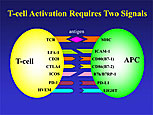Visceral adipose tissue, comprising large metabolic inactive adipocytes leading to increased levels of free fatty acids that mediate insulin resistance (IR), is often in excess in persons with diabetes. A subclinical proinflammatory environment, created by the release from adipocytes of proinflammatory mediators, such as TNF-alpha, contributes in the setting of diabetes to the development of IR and endothelial dysfunction and thus lesion development.
Work by Marx and colleagues to determine why patients with diabetes develop a diffuse and extensive pattern of atherosclerosis has led to their hypothesis that C-peptide could play a role in early atherogenesis in patients with diabetes and IR, by promoting the recruitment of inflammatory cells. A self-promoting effect occurs after the cells enter the vessel wall.
Current understanding of inflammatory atherogenic process
Atherogenesis is an inflammatory process in the vessel wall that begins with endothelial dysfunction (ED) and leads to the formation of fatty streaks and subsequently advanced and potentially complicated lesions. Inflammatory cells are recruited into the vessel wall during ED. Monocyte macrophages adhere to the endothelium, migrate into the vessel wall, take up lipids and differentiate into foam cells. CD4+ lymphocytes enter the vessel wall as TH0 cells, encounter antigens such as oxidized LDL in the subendothelial space and differentiate towards the TH1 cell type, which releases proinflammatory cytokines such as interferon gamma IFG-γ and TNF-alpha. IFG-γ increases the expression of chemokines from the endothelium thereby creating a vicious cycle of cell recruitment and activation of other cells such as monocytes and vascular smooth muscle cells (VSMCs). A self-promoting effect occurs after these cells enter the vessel wall, because they orchestrate and govern the inflammatory response in the vessel wall and lead to further lesion development.
Accelerated inflammatory process
In diabetes, the inflammatory atherogenic process seems accelerated. Marx and colleagues sought to determine the mechanisms that lead to the diffuse and extensive pattern of atherosclerosis they saw in the coronary vascular tree in patients with diabetes (and at a much younger age) while only a single stenosis may be seen in a non-diabetic patient.
Elevated levels of insulin and C-Peptide are found in IR and diabetes. Recent work in renal cells suggests that C-Peptide may activate certain intracellular signaling pathways.
C-Peptide deposition in the intima and subendothelial space of early lesions of patients with IR and ED was shown by Marx and colleagues, while there is none in non-diabetics.
Significantly more C-Peptide deposition in the lesions from 21 patients with diabetes, while only 2 of 21 patients without diabetes had any deposition, in a collaborative study by Marx and colleagues from Louisiana State University
C-Peptide is a chemoattractant for monocytes and T lymphocytes, as shown by Marx and colleagues. Colocalization of monocytes and macrophages with C-Peptide was found in parallel sections of early lesions in an animal model. In contrast, all of the 21 patients with diabetes had C-peptide deposition, but only 75-80% had monocyte macrophages, suggesting C-Peptide deposition occurs first and is followed by monocyte infiltration.
Marx’s group showed through in vitro migration assays that C-Peptide in a concentration-dependent manner increases the migration of monocytes, supporting their hypothesis that C-Peptide in the subendothelial space may act as a chemoattractant, thus facilitating and promoting the recruitment of monocytes into the vessel walls. Interestingly, insulin did not have a similar effect.
They also showed that CD4+ lymphocytes colocalize with C-Peptide, which increases the migration of the CD4+ cells, as shown by in vitro migration assays. Further, the effect of C-Peptide on cell migration is specific to monocytes and T cells, as shown by their work with isolated human neutrophils cells not present in arteriosclerotic lesions where it had no effect.
Intracellular signaling pathways involved in C-Peptide-induced migration
C-Peptide activates PI-3kinase in CD4+ lymphocytes, shown by this group, and in a time-dependent manner it leads to activation of RhoA, RAC-1, and CDC42 in human CD4+ cells. Further, C-Peptide in a time-dependent manner leads to the phosphorylation of PAX, LIM kinase, and cofilin, and leads to activation of ROCK and phosphorylation of MLC.
In some patients, C-Peptide is also present in the media, where it colocalizes with VSMCs. They showed that C-Peptide induces proliferation of VSMCs and interacts on the cell cycle.
Thus, they hypothesized that C-Peptide in high concentrations in patients with diabetes and IR may deposit in the subendothelial space during endothelial dysfunction and facilitate and promote the recruitment of inflammatory cells, monocytes, and T cells, and thus initiate lesion development.
In an animal model of LDL-receptor deficient mice implanted with a pellet that at 12 weeks releases either a C-Peptide or placebo, the preliminary data show at 16 weeks in the aortic arch increased lesion development and marked deposition of monocytes in the C-Peptide group. |


